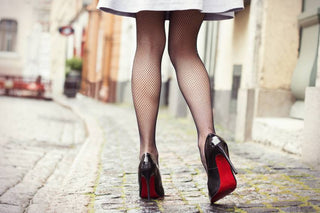Feeling fashion-forward, standing taller, longer looking legs, and that sexy strut – there are plenty of reasons high heels are as popular as they are. But as any woman who has ended the night barefoot and heels-in-hand knows, they can be uncomfortable and downright painful at times. Unfortunately, it appears high heel-related injuries are on the rise.
“Nearly half the injuries happened at home instead of while out, like one might imagine.”
A study, conducted by researchers at the University of Alabama at Birmingham and published in the Journal of Foot and Ankle Injuries, surveyed 1,000 women, nearly half of whom wore high heels despite complaints of foot pain from most of them(71%).
They found that there were almost 125,000 high heel-related injuries reported between 2002 and 2012. And while in 2002, there were 7,097 injuries reported, by 2011, the number skyrocketed to over 19,000.
High Heels are the #1 Culprit of Foot Pain (INFOGRAPHIC)
The most common complaints were by women in their 20s and 30s about foot and ankle sprains and strains; less common injuries included those to the knee, trunk, shoulder, head, and neck. And surprisingly, nearly half the injuries happened at home instead of while out, like one might imagine.
The long-term implications of wearing heels? They can include reduced ankle muscle movement, which could limit the foot’s range of motion, and cause the Achilles tendon to shrink, putting you at risk for injury when you’re not wearing heels and when exercising.
But before you purge your shoe closet, know that there are ways to wear heels without hurting your feet!
Don’t Go Sky High. Five inch heels have become increasingly popular, but heels over 2 to 3 inches in height shift your body weight forward, putting a lot of pressure on the ball of your feet and your toes. Choose shoes that aren’t too high – a slight heel or wedge can be far more comfortable and provide arch support, while still making you look good. And thicker heels or wedges provide much better support than a skinny stiletto.
Pick the Appropriate Occasion. If you’re getting ready for a night on the town, walk around in your slippers and save the high-heels once you make your grand entrance at a party, restaurant, bar, or club. This reduces the risk of getting injured at home and missing a night on the town.
Switch Out Shoes. You don’t need to wear your fancy shoes on the way to work or on your way back home. Instead, take a pair of more comfortable shoes or even foldable flats, and save the heels for when you really need to show them off. The bonus is that your shoes will look great longer because you’ll protect them from rain, dirt, and scuffing! And alternate shoe height on different days. Different height shoes stress different parts of the foot, making you less injury-prone.
Add Cushioning. Cushioned soles can provide shock-absorption, reduce foot pain, and reduce the strain on knees. If your soles don’t come cushioned, adding gel or foam cushions into high heels can provide both comfort and protection. Check out Dr. Scholl’s DreamWalk Ball of Cushions which are engineered to prevent ball of foot pain caused by wearing high heeled shoes.
Watch Where You’re Stepping. Beware of cobblestone streets, grooves in pavement, and curbs – all of which can be a hazard should your heel get caught and throw you off balance.
Exercise to Prevent Pain. You can exercise your feet and body to prevent pain. Flex/stretch your toes, roll a golf ball under the ball, arch, and heel of your foot for flexibility, pick up objects with your toes to stretch the bottoms of your feet, and write the alphabet with your big toe to work the ankles and improve range of motion. In addition, work out your core for better balance, and do hip and leg stretches to minimize the impact heels have on your body beyond your feet.
Provide TLC. Take good care of your feet by using a pumice stone to work off calluses and dry skin. If you’re not getting a regular pedicure, be sure to trim your toe nails. Apply cream on your feet after you shower to prevent them from drying out.
It’s hard to look good when you’re in pain. Thankfully, with these high heel tips, you can look good and feel good, even in cute shoes.

